Trends Report: How To Improve the B2B Buying Process in 2023

The gap between B2C and B2B buying experiences is closing.
As Nick Vincent, Chief Technology Officer at Wunderman Thompson, highlights:
“Your B2B customers today are B2C customers in many other parts of their lives. They realize that commerce can be seamless, fast, efficient, and multi-channel because they see it elsewhere and will hold you to the same standards.”
B2B buyers expect B2C experiences, and your growth depends on your company’s capacity to adapt and improve the buying process in 2023.
How can you do that? In this report we outline:
- Four new B2B buying trends inspired by B2C
- Steps for enhancing your buyers’ experience
- Expert opinions and tips on these trends
B2C vs. B2B buying experiences
When designing purchasing experiences for consumers, B2C companies often focus on
- High transparency: Buyers can easily understand pricing and other relevant information about the product
- Quick sales cycle: It takes a few clicks to purchase a product
- Immediate access to the product: Users can try the product anytime. Usually, through free trials
In most cases, a B2B buying experiences involve:
- Low transparency: Pricing is often purposefully complex
- Long sales cycle: On average prospects will wait three days to see the product
- No access to the product: Usually, prospects won’t see or try the product before a demo call
Many B2B companies still rely on a sales-led model involving sales decks and multiple demo calls. Waiting too long for a demo or having no access to the product translate into a slow, tiring, and frustrating B2B buying experience.
Why Should You Care?
There are multiple reasons why you’ll want to improve the B2B buying experience to follow B2C in 2023.
Risks
- Prospects lose trust in your brand with low transparent about your product or sale processes
- Lengthy sales cycles cause prospects to lose interest or give up on finding a solution to their problem
- Prospects may use the demo waiting time to evaluate your competitors
- Prospects may go with a competitors because it was a faster and easier buying experience
Benefits
- Higher transparency and immediate access to your product leads to a quick sales cycle
- Increase in users’ satisfaction means they’ll be more likely to recommend your product
- Saves your team time by simplifying and automating workflows
- Ensures prospects’ expectations are aligned with your platform’s capabilities
Research
If you’re still wondering if you should improve the purchasing experience, here are some additional resources:
According to The B2B Future Shopper Report by Gorilla, a Wunderman Thompson company:
- 52% of firms are still frustrated with the B2B online purchasing experience.
- 90% of global B2B buyers expect a similar experience buying on a B2B website as they do on a B2C website.
As the B2B Buying Journey Report by Gartner indicates:
- Sales reps lack the opportunity to influence people’s purchasing decisions. As the report shows, B2B buyers spend only 17% of that time meeting with suppliers when considering a purchase. They dedicate the rest of their time to researching independently, online or offline.
- Gartner’s research shows that 77% of B2B buyers find their latest purchases very complex or challenging.
According to Forrester’s 2021 B2B Buying study:
- Buyers go for information everywhere. People will always check third-party platforms to analyze a category’s top contenders.
B2B Buying Trends & Examples
Thanks to the B2B experts’ answers and our customers’ experiences, we’ve identified multiple B2B buying trends that allow companies to create better purchasing experiences and ensure higher results.
Interactive Demos
An interactive demo or product tour involves a pre-designed or pre-filled environment that looks and feels like your SaaS platform. Instead of signing up for a free trial, your users can try the product immediately. The environment allows website visitors to:
- Get a feel of your software
- Visualize your main features
- Experience the value of your product
Companies such as Navattic provide no-code tools for SaaS brands to build interactive demos or that provide self-guided product overviews. This way, prospects can easily access a guided version of your product from the first time they interact with your website.
It’s worth mentioning that companies can offer gated or ungated demo environments, depending on their marketing and sales goals.
Benefits:
- Immediately takes users to their first “Aha” moment
- Guides users through specific features and ensures people won’t feel confused or lost
- Allows you to add pre-filled data to show your product so users don’t need to do any set up to see value
- Ensure your team spends more time with high-value accounts by letting low value accounts self qualify
- Start onboarding your users before they’ve interacted with your pre-sales or sales reps
Examples:
- Ramp, a finance automation platform
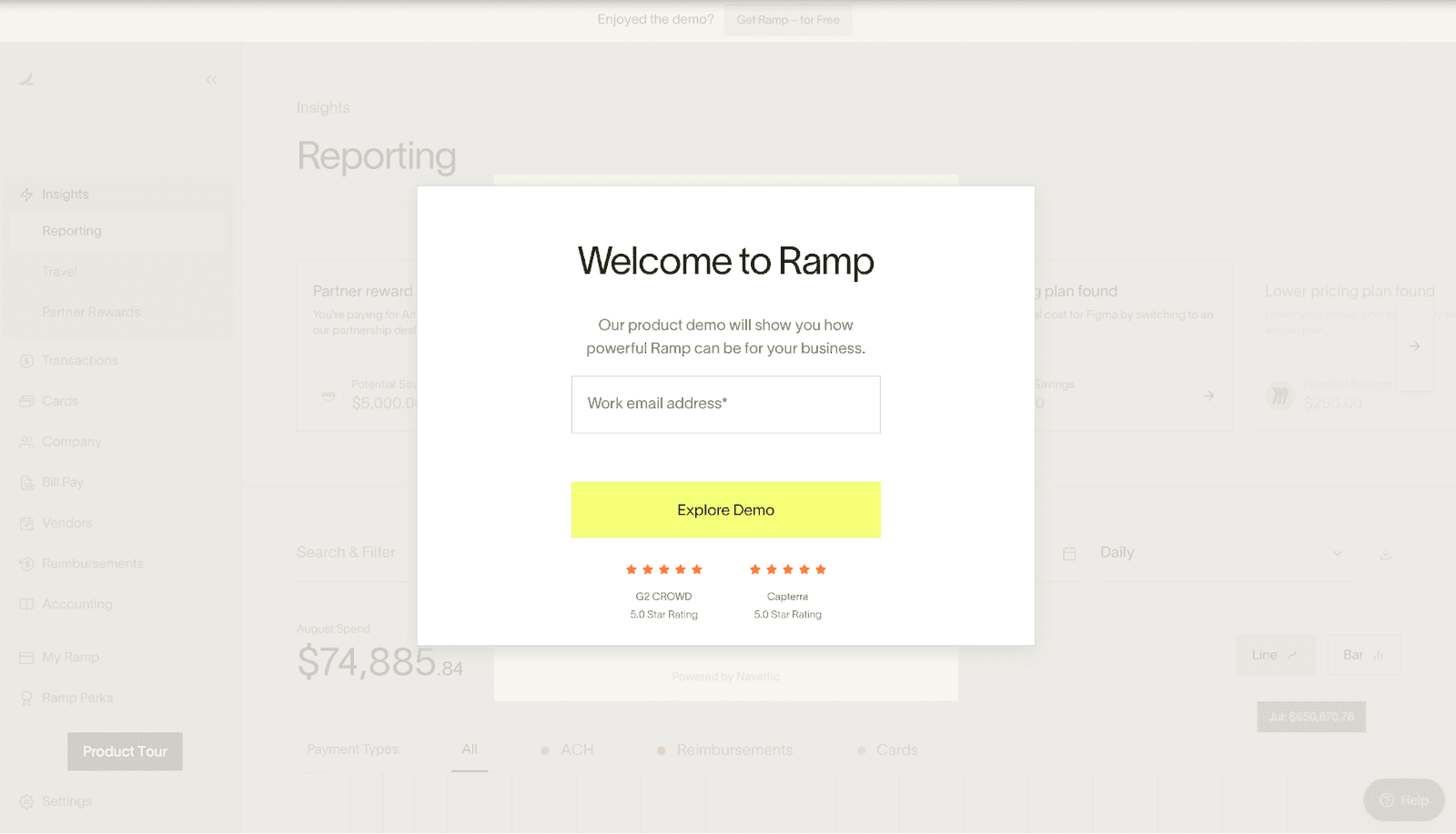
- Dooly, a CRM admin work automation platform
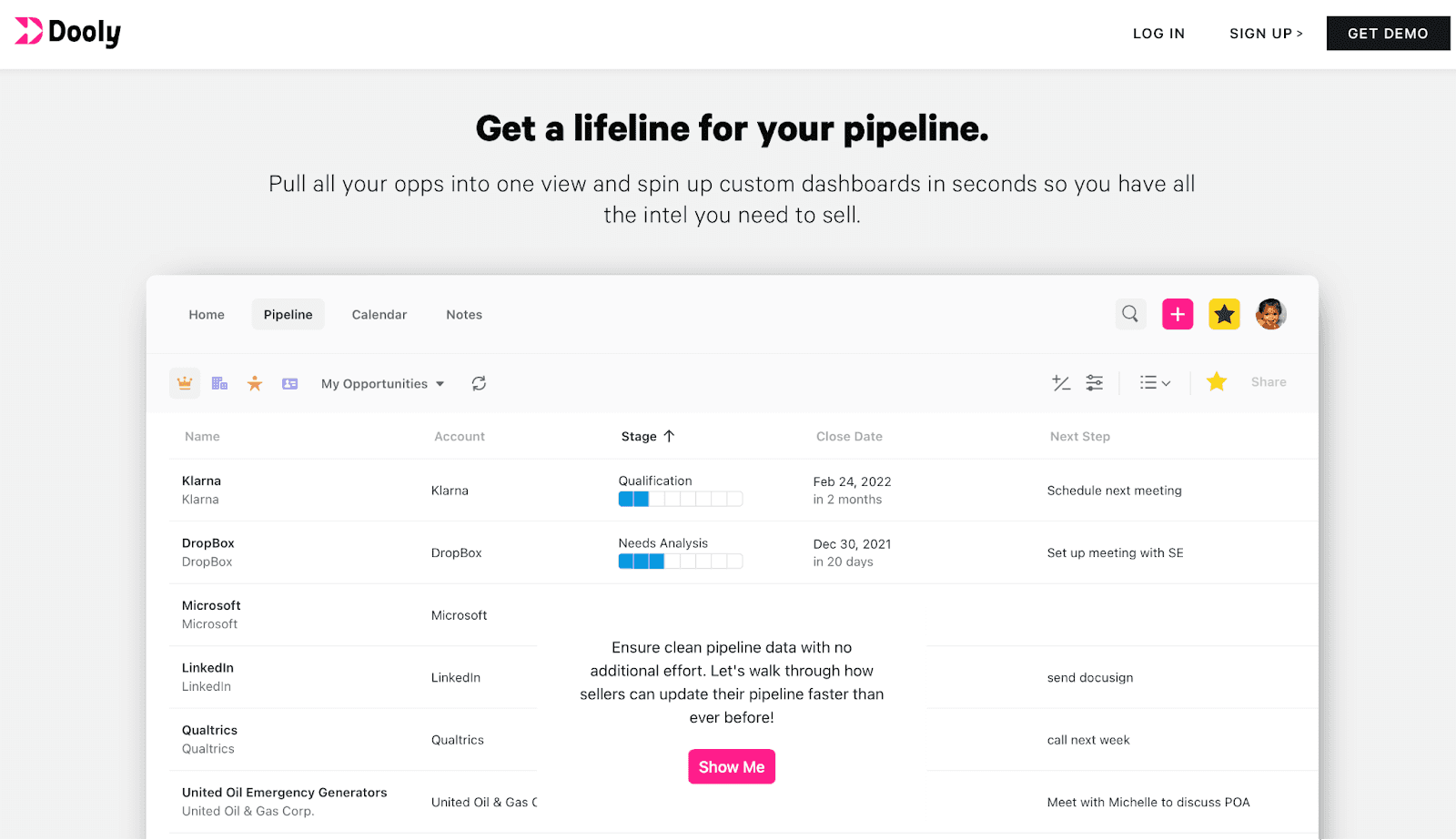
- Front, a customer communication platform

- Citrix, an all-in-one workspace solution
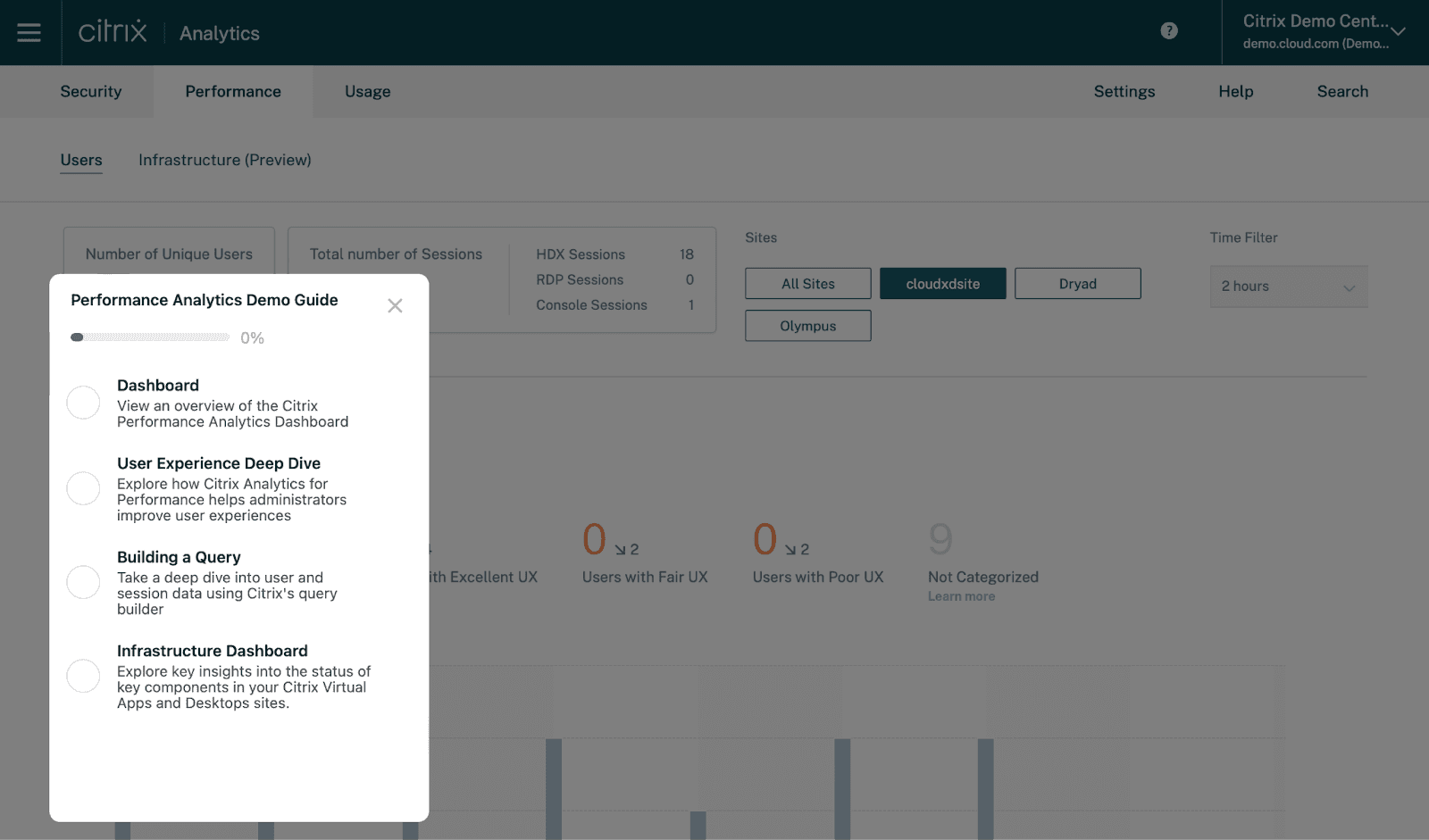
👉 Looking for more product marketing examples? We've got you covered.
Interactive Demo playbook:
Start by understanding why you want to offer a product tour on your website, such as:
- Your platform is too complex and requires users to fill out their data
- Users must introduce sensitive data to get to their first “Aha” moment
- You want to generate qualified leads who better understand your product
Then, you must decide whether you want to create multiple product tours. This decision will depend on the complexity of your product. For example, you may want to create multiple demos if your software offers numerous solutions and use cases.
It’s worth noting that interactive demos work for both PLG and sales-led B2B companies.
To create an interactive demo, you’ll need to consider the following steps:
- Decide whether to gate or not your interactive demo
- Showcase your product functionality in 5 to 15 interactive demo steps (focus on value and “aha” moments)
- At the end of your demo, add a CTA, such as “Book a Call” or “Free Trial”
Expert insights:
📓 James Furbush, VP of Marketing at AccessOne
“Anytime I can just sign up for a product and not have to talk to sales, that’s great. Faster time from demo request to sales handoff.”
📓 Evie Carpenter, Director of Marketing at Chassi
“I love seeing a demo right on a company’s website. To me, it shows how much they believe in their product. They don’t need to trap you on a call or hold your inbox hostage with an infinite drip. It’s like they’re saying: Here’s our product. If you like it and want it, let us know. If not, we’ll be here when you’re ready.”
📓 Spyros Tsoukalas, Head of Content at GrowthMentor
“At GrowthMentor, we have started using extensive product demos for various aspects of our activities, including both mentee and mentor onboarding and pre-acquisition demos. We have just started experimenting with this improvement. We keep receiving positive comments, as getting familiar with our product has become easier and smoother.”
No-signup Trials
Free trials are quintessential to the PLG model. However, some companies took the product experience to a different level by offering no-signup access to their platform. We’re gradually moving from “No credit card required” to “No account.”
In other words, people don’t have to sign up or create an account to access a platform. Users can do a limited number of actions, but when they want to publish a project or access advanced tools, they’re asked to sign up for a free trial.
Benefits:
- Showcase your product’s value right off the bat
- Gain people’s trust and reduce friction to almost zero
- Start the onboarding process right away
Examples:
- Typefully, Twitter thread maker and analytics

- Tally, a form builder platform

- Octopus, a visual sitemap builder
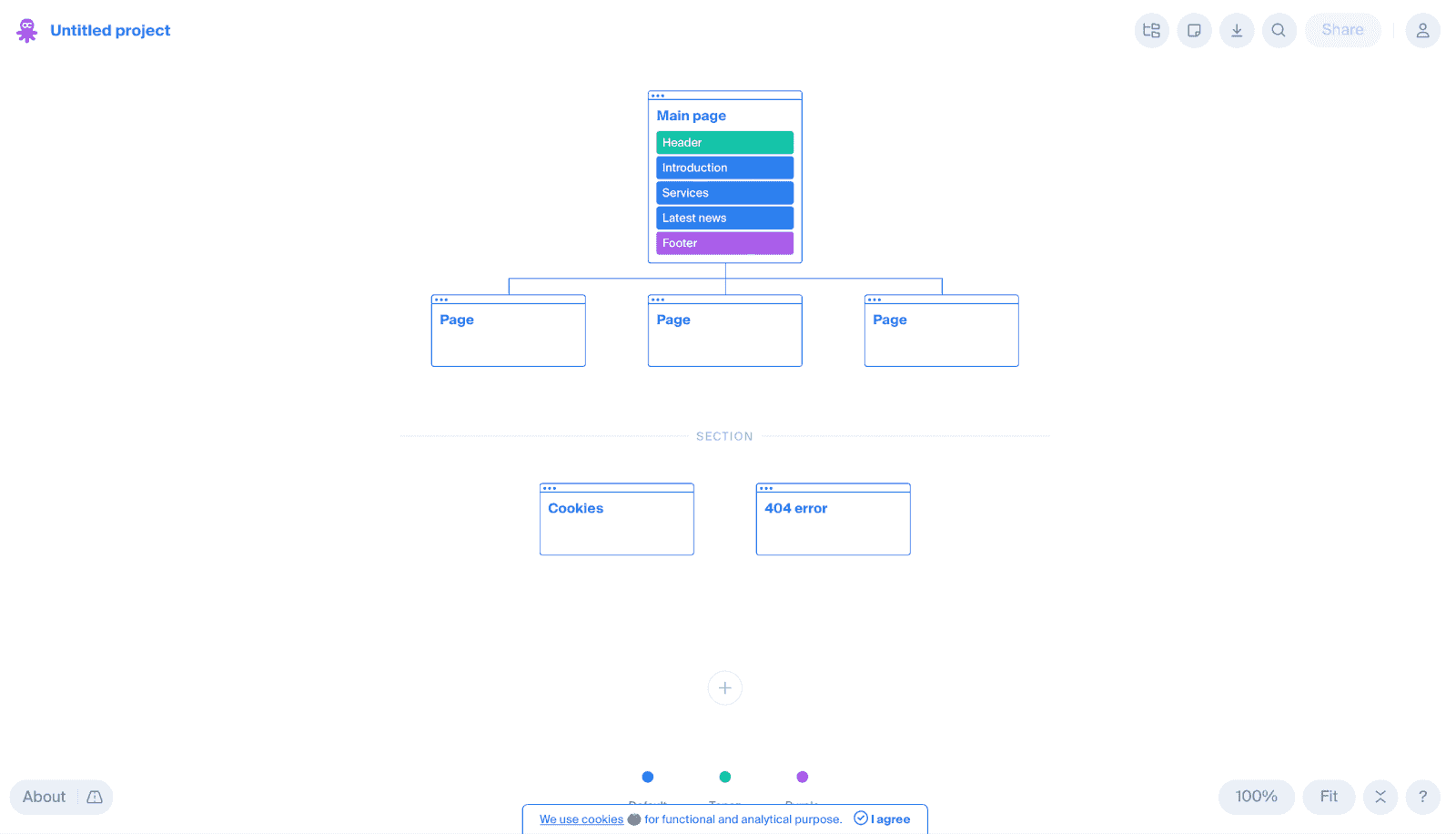
- VEED, a video editing platform

No-signup trials playbook:
Start by asking yourself whether your product is user-friendly and easy to navigate. After all, you don’t want to confuse people with a complex product they can’t use right off the bat.
Also, remember that you can’t provide a no trial sign up without following the product-led model.
To create a no trial sign up you’ll have to consider the following steps:
- Design your users’ experience. Decide which features will stay ungated and what steps will require your users’ signup
- Add onboarding tips and suggestions, ensuring a stress-free user experience
- Track KPIs such as the number of users who tried your product and later sign up for the free trial
Expert insights:
📓 Peter Zawistowicz, Head Of Marketing at Pace
“Pace’s product is built around our customers’ own data. This means we need to find ways to show and prove value before asking potential buyers to share this information with us. We’re exploring ways to show prospects sample data and demo environments for them to get their hands on the product without the hurdle of connecting potentially sensitive data.”
📓 Axel Sukianto, Marketing Director at UpGuard
“B2B is following the footsteps of B2C in terms of self-serve, customization, and frictionless experience. This is only a good thing and forces B2B to innovate.”
📓 Randy Gibson, Director of Growth at Matillion
“I want to put a huge emphasis on B2B PLG as being distinct from PLG in general. We’re bringing our product experience forward so those who cannot use our tool instantly can experience it instantly, even without their own data.”
📓 Vlad Oleksiienko, SDR Team Leader at Reply
“The best buying experience is when one can research, create a free trial, use a product for a while (e.g., freemium model), check all features and integrations they need, and then interact with an AE once they’re ready.”
📓 Maylee Jacob, Brand Strategy at 7shifts
“I think there is a lean into the ability to self-test (more PLG) and understand value too. I know I’ve seen many companies trying to shift to that type of motion, which I like. Both, in my opinion, are positive changes.”
Consulting Sessions
In most cases, demo calls feel salesy. They’re product-centered, as their ultimate goal is to convince prospects to take action and purchase a product. Your narrative will always focus on your company’s interests, even if you’re discussing people’s immediate needs and adjusting your product demo to their profile.
As a result, you’ll experience difficulty gaining people’s trust and build weaker connections with your prospects. To keep this from happening, transform your sales reps into subject-matter experts and demo calls into consulting sessions.
It’s worth noting that your consulting session shouldn’t be too different from your demo calls, except for a higher emphasis on discovery questions which help people reveal the challenges they’ve overlooked.
You may specify the structure of your consulting sessions on the website, including a few minutes for presenting the platform.
Benefits:
- Increase prospects’ trust in your brand by aligning your conversations with their needs and providing value
- Connect and build long-term relationships with your prospect
- Increase the number of qualified leads who may want to get a free consulting session
- Get to know your prospects better and fine-tune your messaging and communication strategy
- Build thought leadership and industry authority
Examples:
Privy, an e-Commerce marketing platform
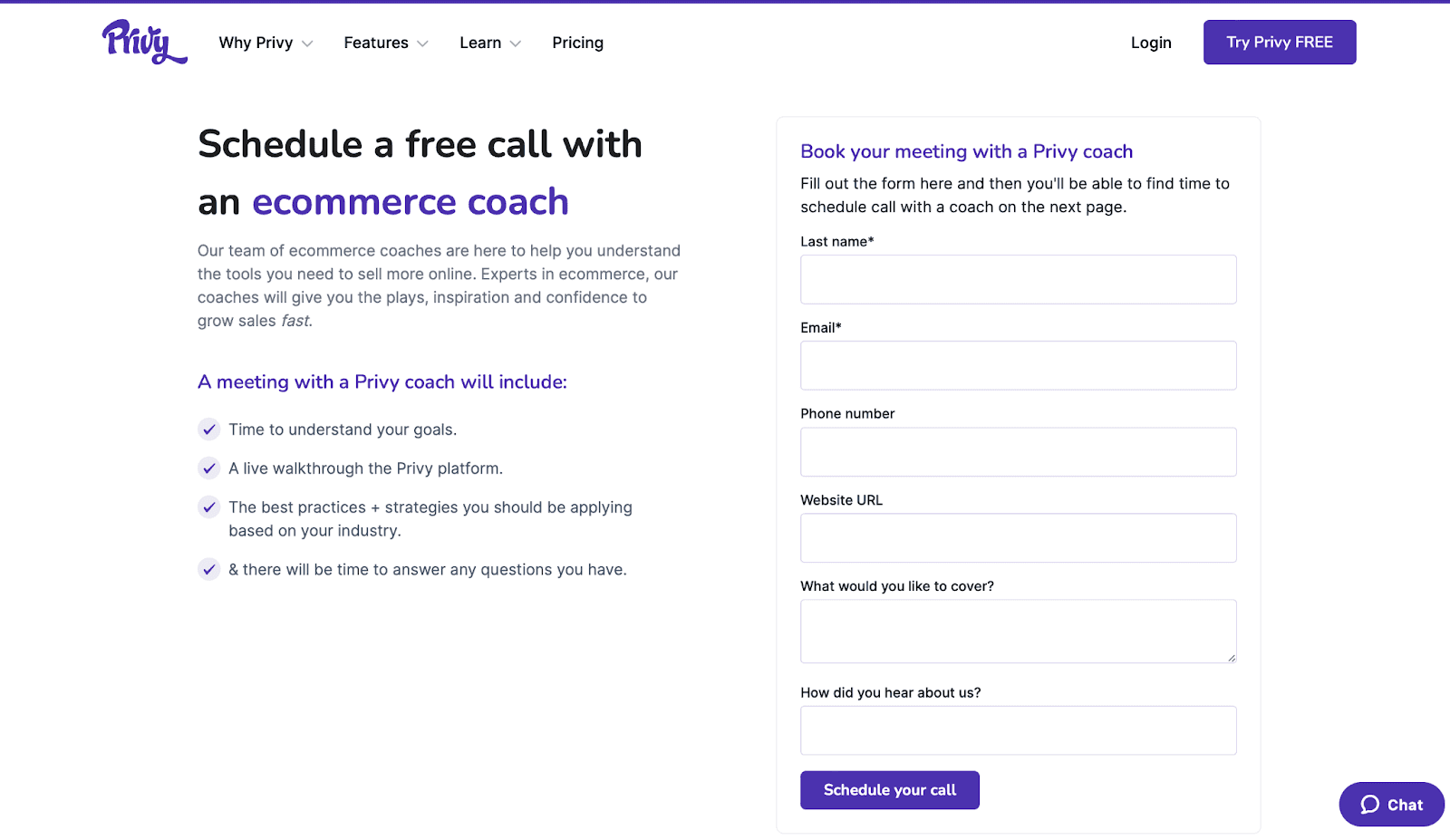
Navattic, a platform for creating interactive product demos
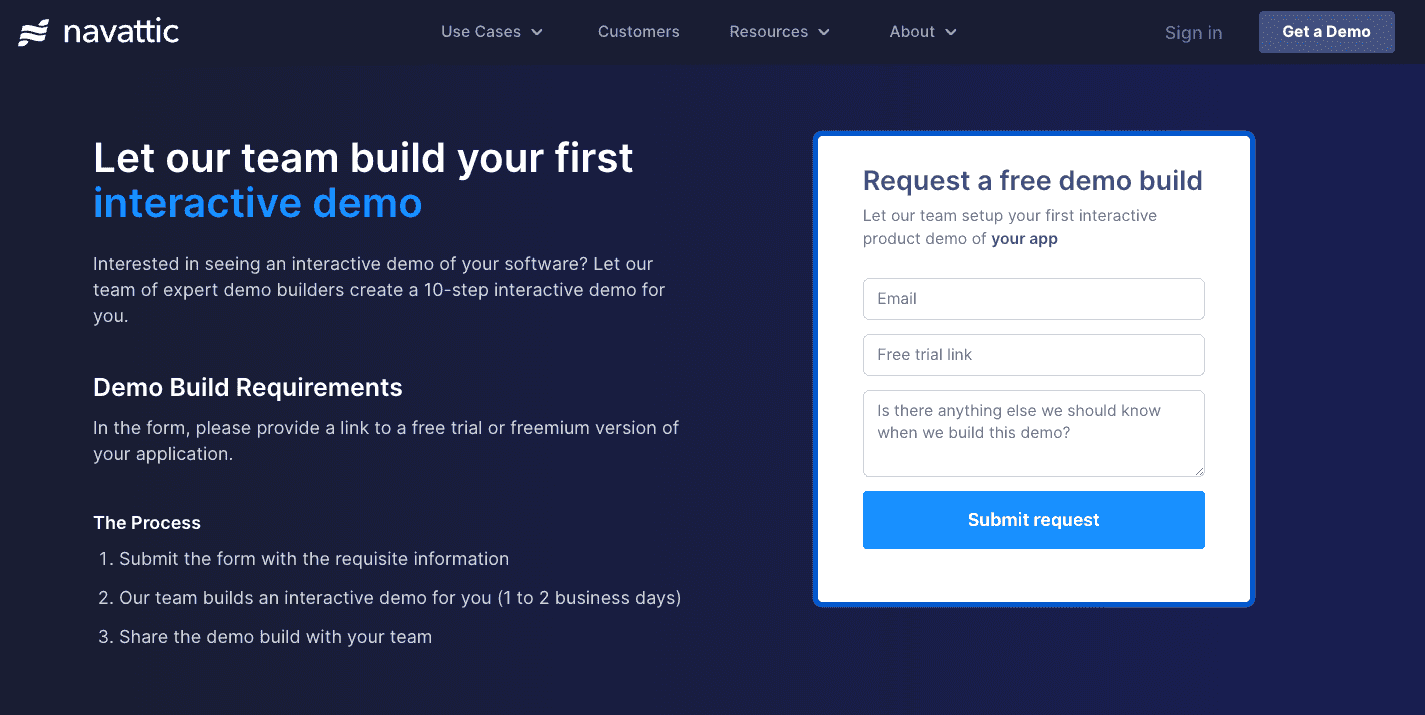
At Navattic, we’re focused on providing immediate value to our prospects and educating them early on on how to create high quality demos.
For prospects who are not ready to see a live demo, we offer a free interactive demo build. That way prospects can easily understand how their software would look without committing to a full sales cycle,
Consulting sessions playbook:
Start by asking yourself what type of expertise you can offer. This will depend greatly on your product and your target group. Subsequently, you can follow the next steps:
- Work with your sales reps, helping them develop consulting skills and competencies
- Rename your demo calls into consulting sessions
- Re-structure your demos gearing the narrative towards your prospects’ goals, needs, and challenges
- Make a list of industry-personalized ideas and best practices you can offer your prospects
- Set the right expectations, mentioning that your consulting session will include a platform walkthrough
- Track the number of prospects you’ll attract by changing your demo calls to consulting sessions
Expert insights:
📓 Ishaan Shakunt, Founder & Head of Marketing Strategy at Spear Growth
“We treat the “Sales” process more like a fitment check plus consultation process. This means that we often say no to companies when they’re not in the right stage to work with us.”
📓 Natalie Marcotullio, Head of Growth at Navattic
“We found some customers were interested in seeing what an interactive demo could do but weren’t ready to jump on a demo yet. Demo builds have been a happy medium and often speed up our sales cycle. Once they’ve seen our demo build, they know the software works for their use case”
📓 Ross Cranwell, CEO & Co-Founder at Milk Video
“The customer can explore the product in their own time, but with guidance from the sales team. If done right, this is a good balance of quickly understanding what a product does and getting additional context from a product expert.”
Simple Pricing Models
Designing a simple pricing structure for your software will help you meet B2B buyers’ growing expectations for an easy purchasing experience, accelerate the buying process, and increase sales productivity.
Complex pricing structures may confuse the B2B buyers, who’re less willing to spend time understanding the value a product can provide. Straightforward pricing is crucial for improving the B2B buying experience as it simplifies people’s decision-making process before purchasing a product.
Benefits:
- Avoid any confusion your prospects may have
- Speed up the sales process
- Increase conversion by keeping things simple
- Reduce the uncertainty and set the right expectations
Examples:
Hopin, an event management platform
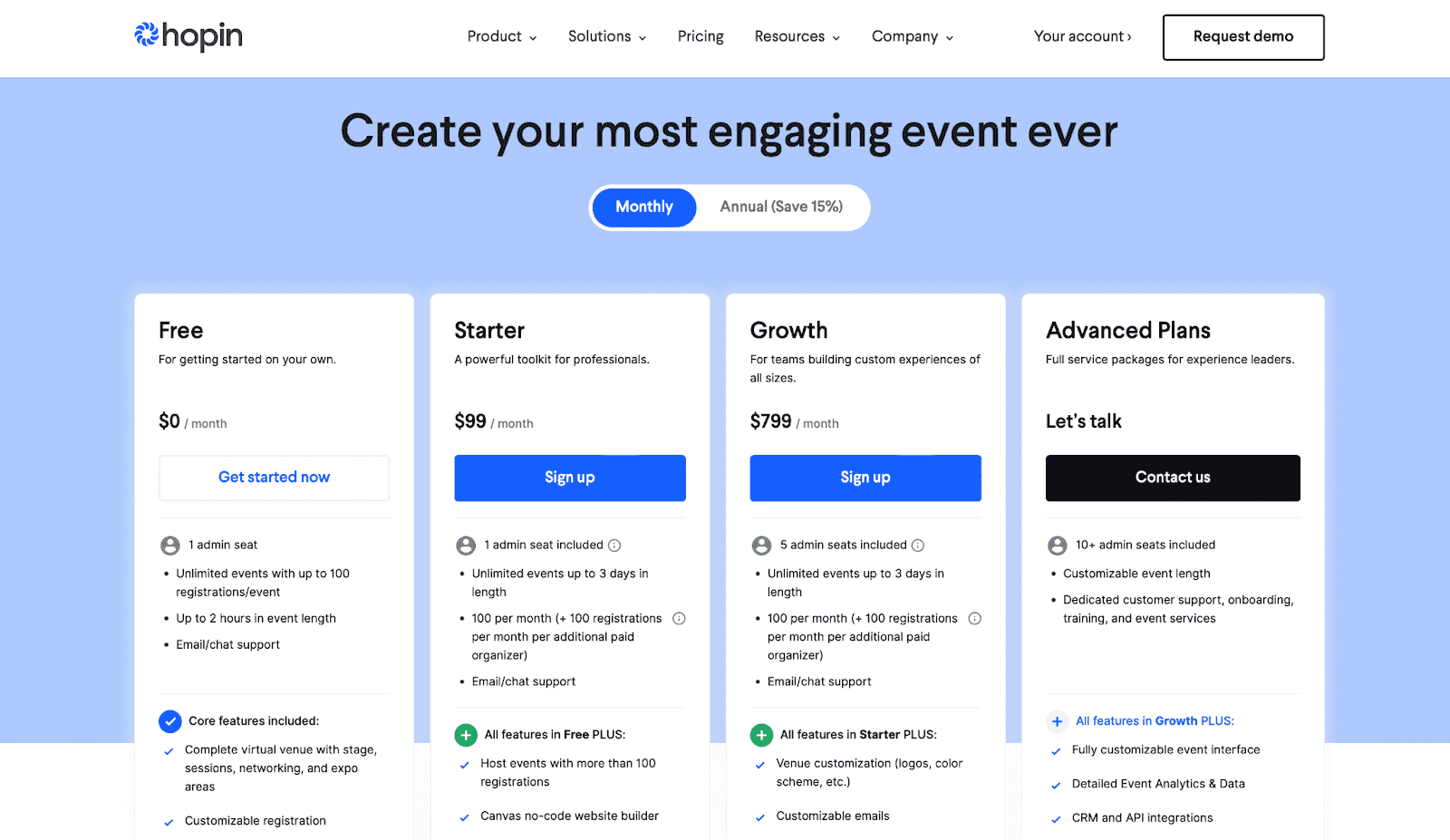
Slack, a messaging platform

Lemlist, a cold email automation platform
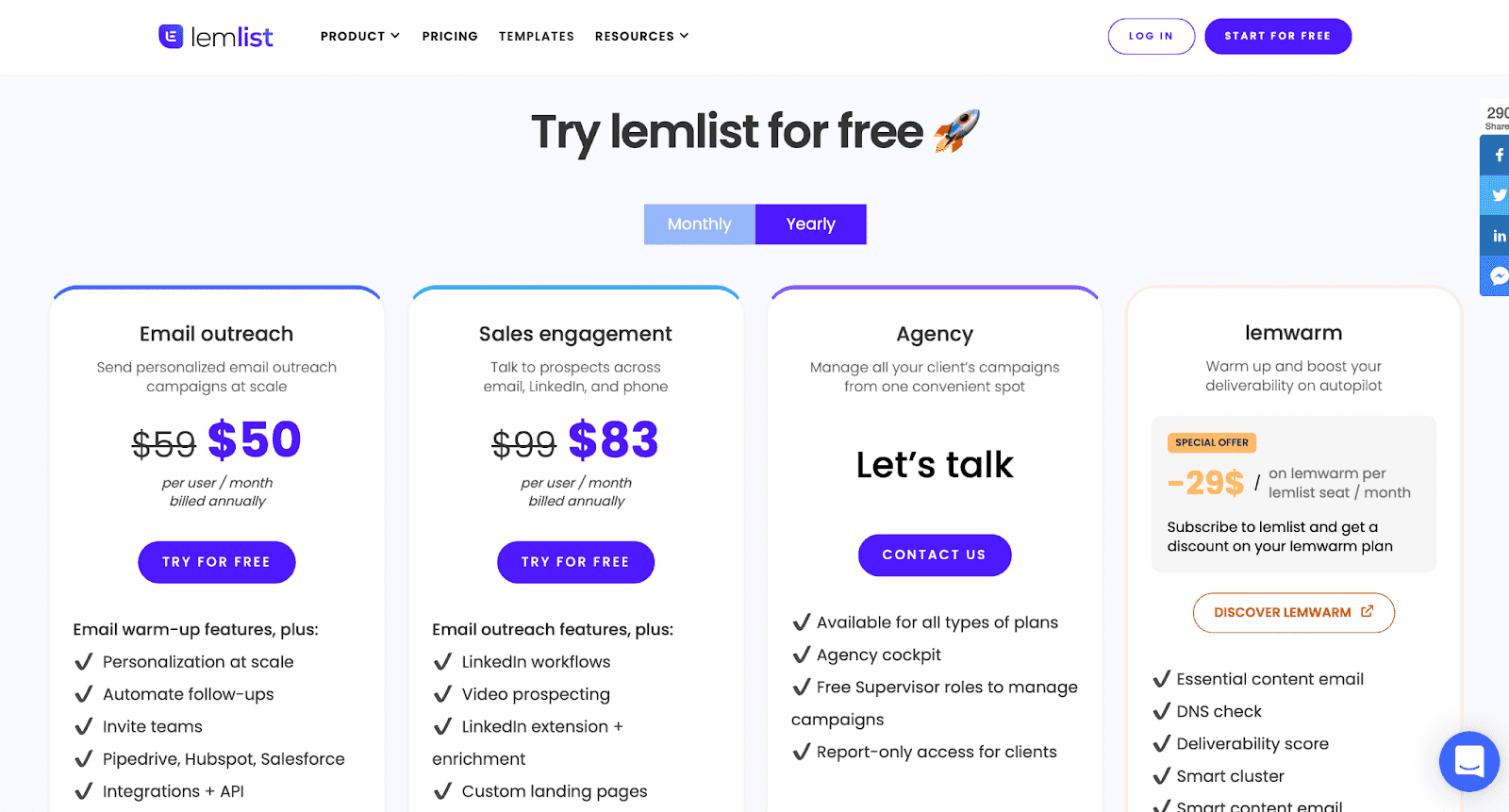
Loom, async video messaging platform
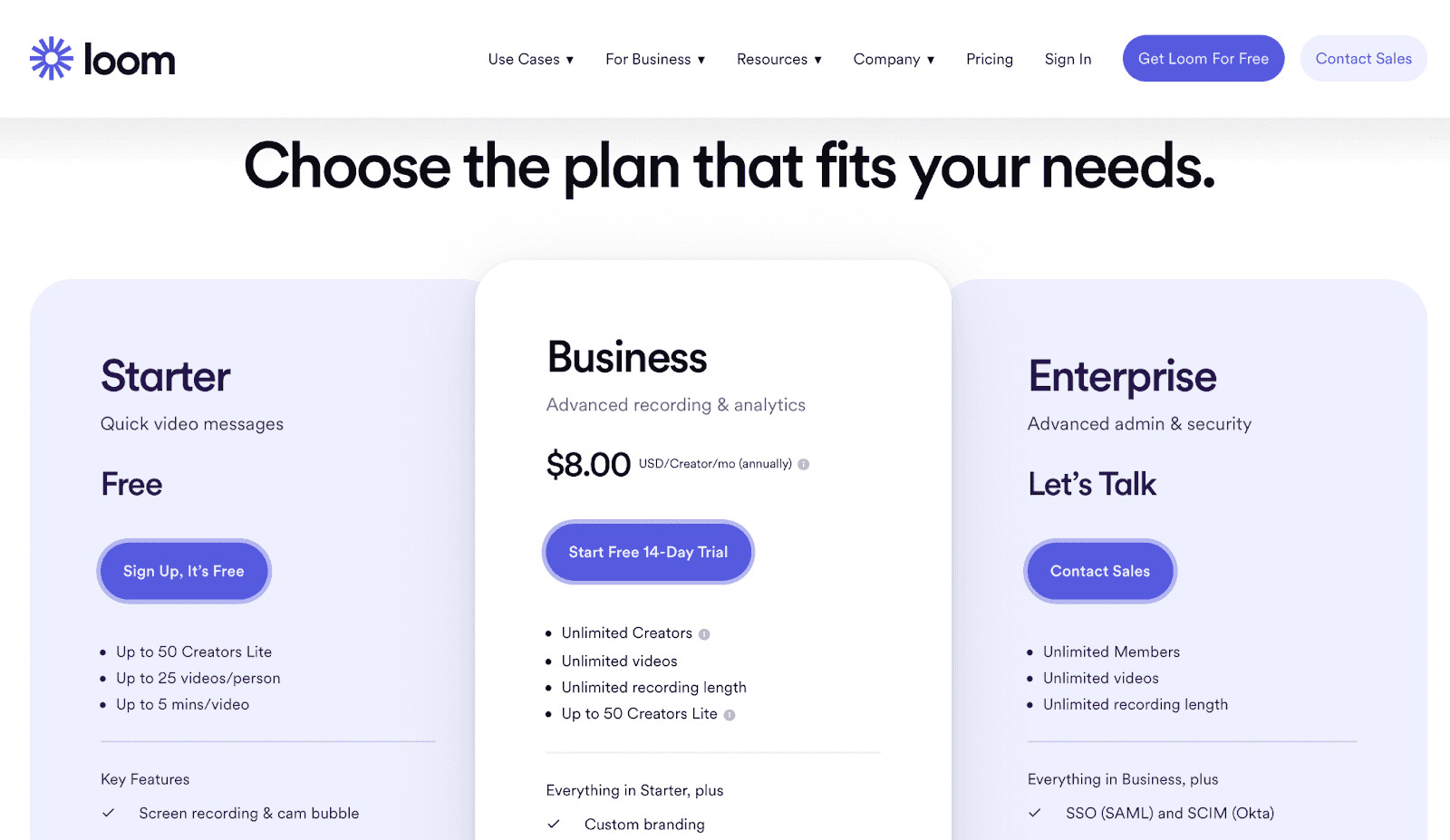
Pricing transparency playbook:
There are multiple SaaS pricing models. Some companies will set up flat-rate pricing, while other brands will focus on identifying the best value-based pricing. From user- to feature-based pricing, there’s no shortage of strategies for identifying your plans.
Remember to keep things simple regardless of the pricing model you choose for your SaaS brand.
Expert insights:
📓 Alexandra Cote, Growth Advisor and Content Lead
“Choosing between plans often gets complicated, and companies can end up paying way more than they should. This has repeatedly halted the purchase decision for prospects, so we decided just to make things as straightforward as possible. Over time, it simplifies the decision-making process for prospects and makes for fewer of those “How much does your tool cost?” inquiries. This naturally speeds up the buying process and removes prospects’ worries.”
📓 Dominik Kovacs, Chief Executive Officer & Founder at Colossyan
“Usage-based pricing is getting more widespread. More transparent information on the website regarding pricing.”
📓 Tamara Yarovoy, Director, Demand Generation at Vena Solutions
“B2B companies need to make it easy on people to buy (Ex: publicly sharing pricing information), and there should be a consistency in user experience regardless of the channel prospect uses to discover the business. It takes fewer steps for prospects to get the information they need. For example, this can be reviving pricing information or getting to a demo.”
2023 Predictions
- We’ll see more and more B2B companies embracing both PLG (for small and medium companies) and sales-led models (for enterprise customers).
- Pricing simplicity will become a must. People will choose one brand over another because of it is a simple to adopt model.
- Providing a feel of the product (via interactive demos, live demos, or free trials) before the pre-sales or sales call will become the standard for the B2B industry.
- We may see new personalized marketing strategies to connect and incentivize employees to use a platform and promote it team or company-wide.
- Some PLG companies may create attractive referral programs for employees. Employees who get their entire teams to use a platform will receive a reward.
- B2B companies will adopt the B2C buying experience guidelines entirely.